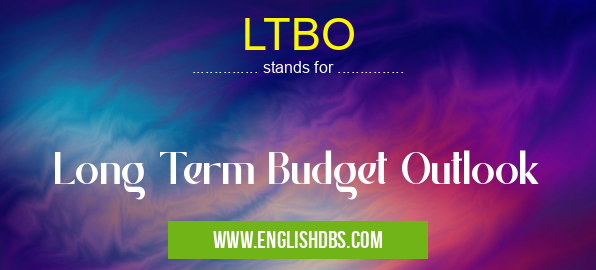What does LTBO mean in UNCLASSIFIED
LTBO is an acronym that stands for Long Term Budget Outlook. It is a comprehensive budget plan used by organizations, governments, and other groups to set out their long-term financial objectives, resources, goals and strategies. LTBO's are typically based on existing trends and projected future needs or objectives of the organization in question. They can range from 10 to 30 years in duration, meaning they provide a comprehensive overview of both short-term and long-term goals and strategies for a period of time. By looking at potential sources of income, expenses, investments and liabilities over multiple years, as well as setting out specific allocation or expenditure limits for each budget item in each year; an LTBO helps to map out a long-term fiscal strategy for an organization.

LTBO meaning in Unclassified in Miscellaneous
LTBO mostly used in an acronym Unclassified in Category Miscellaneous that means Long Term Budget Outlook
Shorthand: LTBO,
Full Form: Long Term Budget Outlook
For more information of "Long Term Budget Outlook", see the section below.
Explanation
Using an LTBO requires extensive research into current and projected economic conditions across multiple levels - such as inflation rates, capital market returns on investments and cash flow analyses - so that accurate assumptions can be made about the expected performance of the organization over the long term. This type of analysis helps decision makers to not only make informed decisions about spending priorities in order to maximize returns on investment but also to understand how individual strategic choices will affect the overall longevity and sustainability of the organization’s financial position over time. In addition to helping inform decisions related to operational management or present requirements it can also help with decisions regarding longer-term projects such as facility maintenance or expansions into new markets or services.
Essential Questions and Answers on Long Term Budget Outlook in "MISCELLANEOUS»UNFILED"
What is the Long Term Budget Outlook?
The Long Term Budget Outlook is a comprehensive analysis of the fiscal and budgetary outlook for the federal government over a period of thirty years. It provides projections of spending, revenue, deficits and debt over this time frame. Additionally, it examines the impact of policy changes on these key variables.
How often does the Long Term Budget Outlook update?
The Congressional Budget Office (CBO) typically releases an updated Long Term Budget Outlook each year in July or August.
Who produces the Long Term Budget Outlook?
The Congressional Budget Office (CBO) creates the Long Term Budget Outlook annually with input from multiple Federal agencies.
How accurate are the projections in the Long Term Budget Outlook?
Due to its macroeconomic scope and long-term time horizon, projections inLong-Term Budget Outlooks are highly uncertain. The CBO uses their best judgment when making future predictions, but they cannot provide assurance that actual outcomes will match their estimates.
What impact do current policies have on long-term budget outlooks?
Current policies can have large implications for deficits and debt down the line. This is why Congress tends to consider both short-term and long-term effects when setting spending and tax policies.
What factors are considered when creating a long term budget outlook?
Multiple economic factors are taken into account when creating a long term budget outlook, including GDP growth rates, labor force participation rates, inflation rates, population aging trends, and health care cost trends.
Does the US national debt effect the long-term budget outlook?
Yes. Currently high levels of government borrowing can restrict fiscal space – that is, available funds for new investments – limiting policymakers’ options in responding to future economic shocks or fiscal demands.
Final Words:
Overall, efficient use of an LTBO allows organizations – including businesses large and small – to take a proactive approach towards managing their finances while being equipped with both short-term tactical options based on current circumstances as well as longer-term strategic options based on their desired future state. While certain assumptions may necessarily need to change depending upon particular economic indicators over time; having such a clear view of both risks faced by a business as well as potential opportunities available allows greater certainty in taking any number of courses for growth over multiple years.
